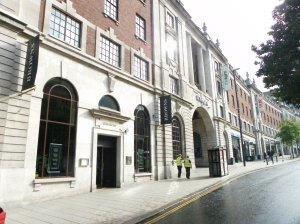It is of course quite unoriginal to say that we can learn much of the history of a town or city by looking at its buildings, signs, street furniture and the like. But I have had an illustration of this from the buildings of Leeds that is so striking that it is worth some discussion.

 The Headrow, opened in 1930 and replacing the old Upper and Lower Headrows, was promoted by the then leader of the city council, Sir Charles Wilson, as the main street of the city – and no doubt as his own monument. Lettice Cooper, in her 1950 portrait of the West Riding in the Robert Hale “County Books” series, says that the Headrow is “much more like a street in a great city than any other that I know of in a West Riding town.” If this is true I do not know that it is saying much. The buildings lining the Headrow are of a subdued baroque style that was then still all too common. Baroque was popular for some decades from the late nineteenth century, and this did produce one or two masterpieces, for example the city halls of Glasgow and Belfast. But as the twentieth century got into its stride it began to lose the exuberance that it needed if it was to produce great work; and yet it was not uncompromisingly severe in the manner of the modernism which was replacing it by 1930. The result is half-hearted ornamentation, seen above in the balustrades and the flaming urns worked into the Portland stone above the parapets, in otherwise plain frontages with an emphasis on the verticals. What was supposed to be the city’s focal point is caught for ever at this decadent moment.
The Headrow, opened in 1930 and replacing the old Upper and Lower Headrows, was promoted by the then leader of the city council, Sir Charles Wilson, as the main street of the city – and no doubt as his own monument. Lettice Cooper, in her 1950 portrait of the West Riding in the Robert Hale “County Books” series, says that the Headrow is “much more like a street in a great city than any other that I know of in a West Riding town.” If this is true I do not know that it is saying much. The buildings lining the Headrow are of a subdued baroque style that was then still all too common. Baroque was popular for some decades from the late nineteenth century, and this did produce one or two masterpieces, for example the city halls of Glasgow and Belfast. But as the twentieth century got into its stride it began to lose the exuberance that it needed if it was to produce great work; and yet it was not uncompromisingly severe in the manner of the modernism which was replacing it by 1930. The result is half-hearted ornamentation, seen above in the balustrades and the flaming urns worked into the Portland stone above the parapets, in otherwise plain frontages with an emphasis on the verticals. What was supposed to be the city’s focal point is caught for ever at this decadent moment.
Turn south into Briggate and you cross a fault line. The effect is like a sharp tilt of the earth towards the sun. For from here on you encounter the best of the city’s Victoriana, where high-spirited ornamentation runs free, unashamed in its eccentricity.
 The terracotta of Frank Matcham’s County Arcade (right) probably takes this closest to its logical conclusion. Look also at the view along Albion Place and King Edward Street to see just what a long sweeping perspective ought to be:
The terracotta of Frank Matcham’s County Arcade (right) probably takes this closest to its logical conclusion. Look also at the view along Albion Place and King Edward Street to see just what a long sweeping perspective ought to be:
And by the time we reach Boar Lane the effect is as intense as it gets:
Whatever the grand ideas for what the Headrow was to be, it is abruptly clear as we walk and gaze that the heart and epitome of Leeds remained elsewhere and had been given to us by the vitality and high spirits of an earlier time.



